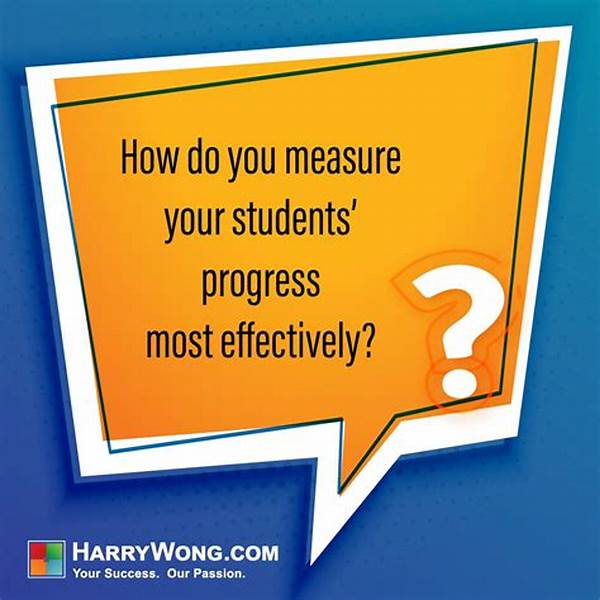In the realm of education, understanding and tracking student progress is quintessential to ensuring academic success and personal development. The concept of measuring student progress effectively involves a comprehensive evaluation of student engagement, comprehension, and performance. Such a multifaceted approach not only provides insights into a student’s learning trajectory but also informs instructional methodologies and curriculum adjustments. As educational paradigms shift towards personalized learning, it becomes increasingly important for educators to implement robust strategies to measure student progress in an accurate and meaningful way.
Read Now : Plagiarism’s Role In Academic Performance
The Importance of Measuring Student Progress
In an educational landscape characterized by diversity, measuring student progress effectively is crucial for a myriad of reasons. Firstly, it serves as a diagnostic tool, identifying areas of strength and weakness, thereby allowing for targeted interventions. Secondly, effective measurement can motivate students by providing them with tangible evidence of their growth and areas needing improvement. Lastly, it offers teachers valuable insights into their instructional effectiveness, enabling them to refine their teaching methods. Without a systematic approach to measuring progress, stakeholders would lack the data necessary to make informed decisions that promote academic success.
Different strategies contribute to measuring student progress effectively, including formative assessments, summative evaluations, and the use of digital learning analytics. Formative assessments, which include quizzes, peer reviews, and self-assessments, offer continuous feedback that can steer day-to-day learning. Summative evaluations, such as end-of-term exams, provide a comprehensive overview of student achievement. Furthermore, digital learning platforms can yield vital analytics that shed light on student behavior and performance trends over time. Each of these methods plays a crucial role in painting a holistic picture of student progress.
Methods of Measuring Student Progress
1. Standardized Testing: An objective means of measuring student progress effectively, allowing comparisons across different demographic groups.
2. Portfolio Assessments: Offers qualitative insights into a student’s skills through collected works over a semester or year.
3. Performance-Based Assessments: Evaluates a student’s ability to apply knowledge in real-world situations, thus ensuring skills are practical and applicable.
4. Peer Reviews: Encourages collaboration and critical thinking among students, aiding in identifying areas of strength and improvement.
5. Self-Assessments: Empowers students to reflect on their own learning journeys, fostering a sense of responsibility and self-awareness.
The Role of Technology in Measuring Progress
The advent of digital technology has revolutionized the approach to measuring student progress effectively. Advanced software solutions now enable educators to harness vast amounts of data that offer real-time insights into student engagement and achievement. Learning management systems (LMS) and educational analytics platforms facilitate a customized analysis of student performance, informing educators about how different students progress over time. This means that instruction can be tailored to each student’s unique needs, enhancing the overall educational experience and outcomes.
Furthermore, online assessments can be designed to be adaptive, adjusting the level of difficulty based on the student’s responses. This capability ensures that learners are challenged appropriately, keeping them engaged and motivated. Additionally, digital platforms can include normalized scores and benchmarks, making it easier for educators to compare student progress on a broader scale. By integrating technology in measuring student progress effectively, the scope of educational analysis expands significantly, potentially transforming educational strategies and policies.
Read Now : Ensuring Data Collection Accuracy
Challenges in Measuring Student Progress
Effectively measuring student progress poses numerous challenges that educators must navigate. Firstly, there is the issue of standardization. While standardized tests offer a uniform measure, they may not account for individual student differences, potentially skewing results. Secondly, ensuring that assessments are comprehensive yet still measurable often results in a trade-off between depth and breadth. Lastly, achieving a balance between qualitative and quantitative measures to ensure a full and fair assessment of progress remains an ongoing challenge for educators and administrators alike.
Additionally, educators need to be mindful of biases that may inadvertently influence the evaluation process. Cultural, socio-economic, and language differences can affect performance and be misinterpreted as indications of a student’s capabilities when better understanding and adaptation to student backgrounds might reveal different insights. Furthermore, resource constraints can limit the ability to implement diverse and sophisticated assessment strategies. Addressing these challenges requires collaborative efforts among educational institutions, policy-makers, and communities.
Integrating Multi-Faceted Assessment Approaches
Incorporating multiple assessment methodologies is essential for measuring student progress effectively. This integrative approach acknowledges the multifaceted nature of learning and seeks to provide a clearer and more rounded understanding of student achievements. Blending traditional assessments with innovative, technology-based evaluations can yield a comprehensive view of student ability. For instance, combining test scores with project-based assessments and peer reviews can highlight different competencies and learning styles.
Educational success relies on understanding individual student needs and adapting teaching approaches accordingly. By diversifying assessments, educators can better appreciate student capabilities beyond mere academic performance. Comprehensive reporting, which includes narrative feedback, graphical data representation, and comparative analysis, can further enhance understanding and communication of student progress to parents and other stakeholders. Prioritizing such holistic evaluation systems ensures a robust framework for academic guidance and growth, contributing significantly to the educational development of students.
Best Practices for Measuring Progress
Implementing best practices is vital when it comes to measuring student progress effectively. Firstly, recognizing diversity in learning styles and tailoring assessments accordingly ensures students have equitable opportunities to demonstrate their understanding. Secondly, ongoing teacher training and development are critical in keeping educators adept at leveraging both traditional and digital assessment tools. Thirdly, frequent feedback loops enable real-time insights into student progress, facilitating timely interventions.
Regularly updating assessment tools and methodologies to reflect current pedagogical advancements is also necessary. This includes integrating culturally responsive pedagogies that recognize and value students’ backgrounds and experiences. Engaging students in the creation of their learning goals and assessments fosters ownership and motivation. Lastly, establishing strong communication channels with parents and caretakers ensures that they are active participants in the educational journey, reinforcing the importance and value of measuring student progress effectively.
